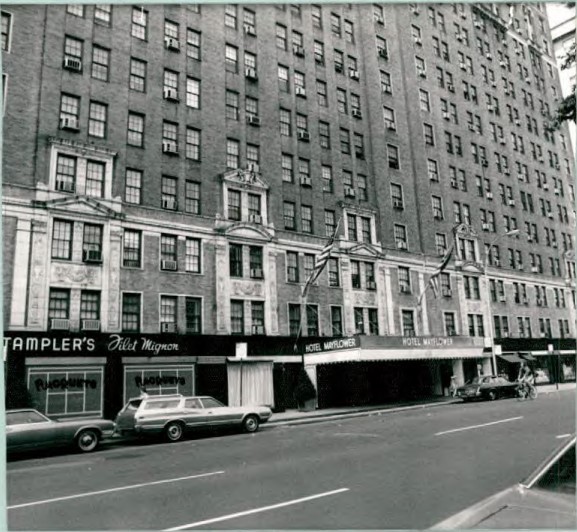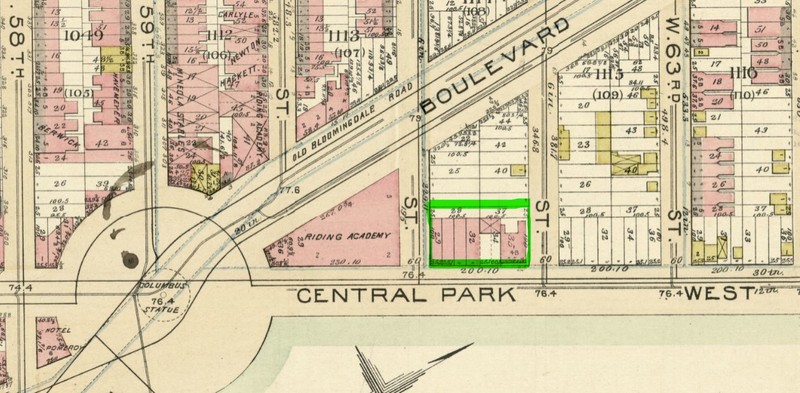Hotel Mayflower (1926-2004)
Introduction
Text-to-speech Audio
Commemorated today by a bench on Broadway that bears a small plaque funded as a memorial to the former New York landmark, Hotel Mayflower stood for nearly eight decades at this location before being demolished and replaced by 15 Central Park West Hotel Mayflower was a 15-story building that stretched between W. 61st and W. 62nd Streets. The structure was one of seven buildings on this street that were designed by the prolific architect Emery Roth between 1926 and 1930. The apartment hotel was constructed in 1926 and overlooked Central Park which is across the street. Hotel Mayflower was listed in the New York and National Registers in 1982, but by that time, the aging, 365-room hotel was being targeted by real estate developers who hoped to demolish the structure. The property was sold to developers in 2004. After spending millions to buy out and relocate the last remaining tenants in rent-controlled apartments on the upper floors, the building was demolished to build the high-rise condominium building that now occupies the space, with the entrance at 15 Central Park West.
Images
Main (east) facade of former Hotel Mayflower along Central Park West in 1975 photo (Howard)

Future location of Hotel Mayflower (green) on 1894 atlas map of New York (Bromley p. 23)

1863 panoramic sketch map of lower Eighth Avenue (Central Park West) along west side of Central Park (Bachmann)

Backstory and Context
Text-to-speech Audio
The street along the western edge of the newly-created Central Park was known as Eighth Avenue in the 1860s and was sparsely developed; the portion of the street adjacent to the park came to be known as Central Park West by the 1890s. The block of Central Park West between W. 61st and W. 62nd Street (futire location for The Hotel Mayflower) was developed by 1894 with four brick buildings in the south half of the block and one brick building and a brick stable on the north half of the block (see the Bromley map image below). One of these buildings was the birthplace in 1898 of composer Vincent Youmans (known for the song "Tea for Two" from "No, No Nanette").
The general contractor for construction of The Hotel Mayflower in 1926 was Joseph E. Gilbert. The architect, Emery Roth, left his mark on a number of buildings along this street and elsewhere in town. The hotel was generally known as a unpretentious place to stay overlooking Central Park but had a few notable occupants, including the producer of the first silent Felix the Cat cartoon films, Patrick Sullivan (1885-1933).
The owners in 1982 reportedly stripped The Hotel Mayflower's terra cotta ornamentation - pilasters, cherubim, swags - from its exterior; the New York Times called the hotel a "drab brown" building in 2004. Developers William and Arthur Zeckendorf purchased the hotel and several adjacent lots for over $400 million in 2004. A liquidation sale at the hotel in 2004 offered everything from a Yamaha baby grand piano for $6,500 to dozens of pedestal sinks and television sets.
The last four residents of the rent-controlled apartments in The Hotel Mayflower were not allowed to be evicted, by terms of their leases. The bachelors had resided in their respective, tiny apartments in the north half of the hotel for 30 to 35 years. The men earned from a million to 17 million dollars apiece for their trouble to move someplace else, with the last holdout costing the Zeckendorfs the most. One was a 98-year-old with relatives in Mexico. Another was a former show-business agent in his 90s. The third was the son of famed World War II U.S. General Douglas MacArthur and was living under an assumed name to escape the shadow of his famous father. The last holdout had been living two floors above the building's highest elevator landing and had no desire to leave his home since 1974. A genius with multiple degrees in physics and a medical degree, he wanted another apartment with as nice of a view - the apartment had views of Central Park, the East River, and the Hudson River. The final tenant even held his ground after the developers began demolishing the southern end of the hotel. Eventually, he settled for a $2 million condo in the Essex House and another $15 million. In return, the developers received the princely sum of a dollar in monthly rent on the condo, paid for ten years in advance with a $120 check. The individual almost completed their ten-year stay in the Essex House, living there for a dollar per month until his death at age 80 in 2011.
Cite This Entry
Paonessa, Laurie and Clio Admin. "Hotel Mayflower (1926-2004)." Clio: Your Guide to History. August 28, 2021. Accessed July 30, 2025. https://theclio.com/tour/2042/1
Sources
Dunlap, David W. "An Old and Comfortable Face is Leaving the Park's Side." New York Times (New York, NY) November 4th 2004.
Gross, Michael. "Hotel hermit got $17M to make way for 15 Central Park West." New York Post (New York, NY) March 2nd 2014. , Metro sec.
Howard, Alexandra Cushing. Building-Structure Inventory Form for The Hotel Mayflower, New York, N.Y.. Albany, NY. Division for Historic Preservation, New York State Parks and Recreation, 1975.
Pujol, Rolando. Long-ago demolished Mayflower Hotel still offering hospitality (sort of), The Retrologist. Blog.. April 11th 2017. Accessed August 26th 2021. https://retrologist.com/post/20892754101/long-ago-demolished-mayflower-hotel-still-offering.
New York State Cultural Resource Information System (NYS CRIS): https://cris.parks.ny.gov/Default.aspx
Library of Congress (LOC): https://www.loc.gov/item/2010587355/
New York Public Library (NYPL): https://digitalcollections.nypl.org/items/510d47e3-cbd4-a3d9-e040-e00a18064a99

